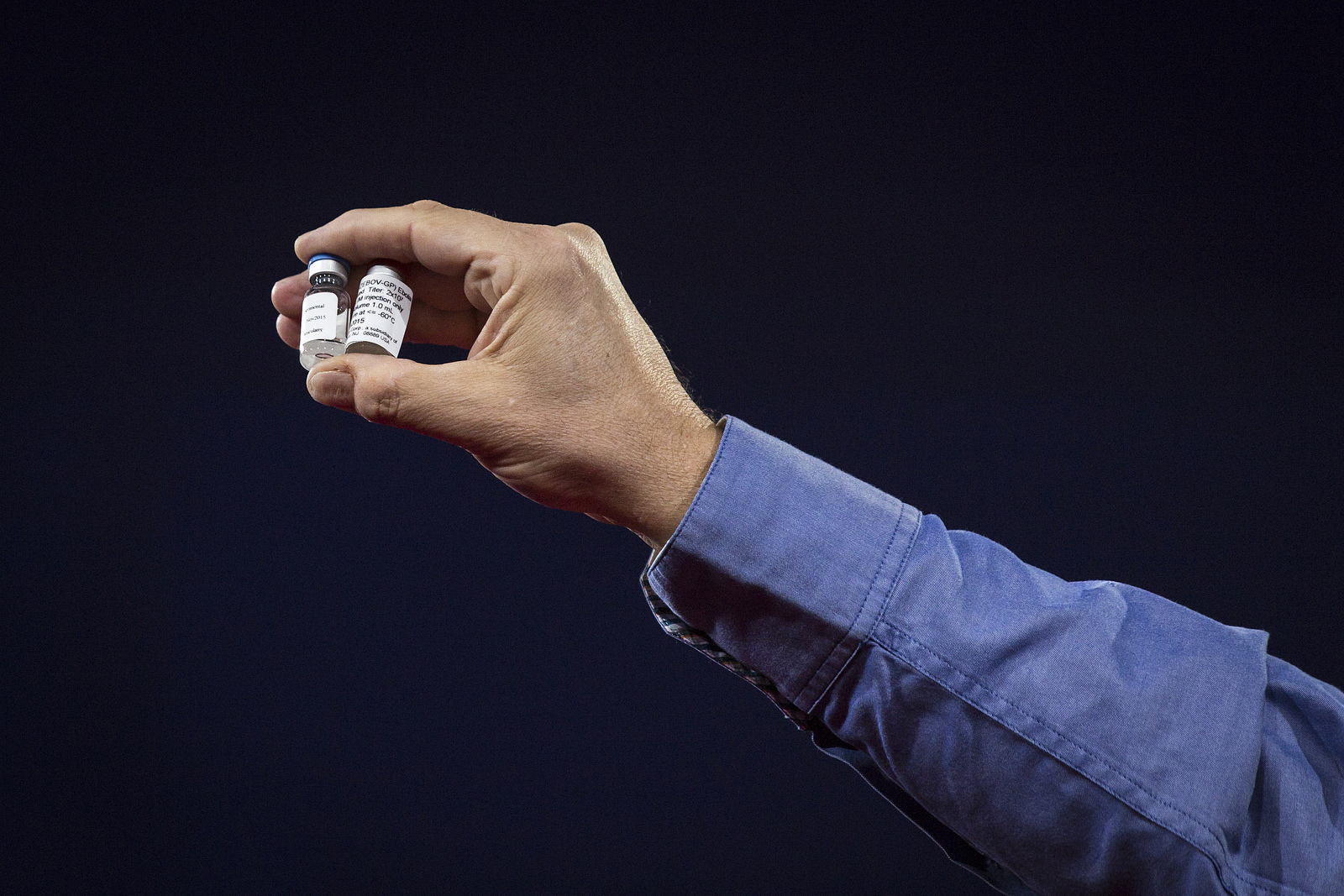
At TED2015, Seth Berkley showed two Ebola vaccines under review at the time. One of these vaccines is now being deployed in the current Ebola outbreak in the DRC. Photo: Bret Hartman/TED
Dr. Seth Berkley is an epidemiologist and the CEO of Gavi, the Vaccine Alliance, a global health organization dedicated to improving access to vaccines in developing countries. When he last spoke at TED, in 2015, Seth showed the audience two experimental vaccines for Ebola — both of them in active testing at the time, as the world grappled with the deadly 2014–2016 outbreak. Just last week, one of these vaccines, the Merck rVSV-ZEBOV, was deployed in the Democratic Republic of the Congo to help slow the spread of a new Ebola outbreak in and around the city of Mbandaka. With more than 30 confirmed cases and a contact list of more than 600 people who may be at risk, the situation in the DRC is “on a knife edge,” according to the World Health Organization. Seth flew to the DRC to help launch the vaccine; now back in Geneva, he spoke to TED on the challenges of vaccine development and the stunning risks we are overlooking around global health epidemics.
This interview has been edited and condensed.
You were on the scene in Mbandaka; what were you working on there?
My role was to launch the vaccine — to make sure that this technology which wasn’t going to get made was made, and was made available in case there was another big emergency. And lo and behold, there it is. Obviously, given the emergency nature, a lot of the activity recently has been about how to accelerate the work and prepare the critical pieces that are going to be necessary to get this under control, and not have it spin out of control.
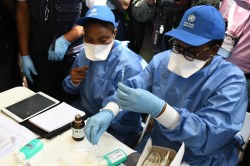
Health workers in the DRC prepare the first dose of the Ebola vaccine. Photo: Pascal Emmanuel Barollier/Gavi
This is the ninth outbreak in the DRC. They are more experienced [with Ebola] than any other country in the world, but the DRC is a massive country, and the people in Mbandaka, Bikoro and Iboko are in very isolated communities. The challenge right now is to set up the basic pillars of Ebola care — basic infection control procedures, making sure that you identify every case, that you create a line-list of cases, and that you identify the context that those cases have had. All of that is the prerequisite to vaccination.
The other thing you have to do is educate the population. They know vaccines — we vaccinate for all diseases in DRC, as we do across most countries in Africa — but the challenge is, people know we do vaccine campaigns where everybody goes to a clinic and get vaccinations, so the idea that somebody comes to your community, goes to a sick person’s house, and vaccinates just people in that house and surrounding family and friends is a concept that won’t make sense. The other important thing is, although the vaccine was 100% effective in the clinical trial … well, it’s 100% effective after 10 days, so people who were already incubating Ebola will go ahead and get diseased. If people don’t understand that, then they’re going to say the vaccine didn’t work and that the vaccine gave them Ebola.
The good news is, logistics is set up. There is an air-bridge from Kinshasa, there’s helicopters to go out to Bikoro, a cold chain of the vaccine is set up in Mbandaka and Bikoro, and there are these cool carriers that keep the vaccine cold so you can transport it out to vaccination campaigns in isolated areas. We have 16,000 doses there, with 300,000 doses total, and we can release more doses as it makes sense.
You mentioned the local communities — how do you navigate that intersection of medical necessity and the lack of education or misinformation? I read that some people are refusing medical treatment and are turning to local healers or churches, instead of getting vaccinated.
There is no treatment right now available in DRC; the hope is that some experimental treatments will come in. We don’t have the equivalent for the vaccines on the treatment side. It’s going to be very important to get those treatments because, without them, what you’re saying to people is: Leave your loved ones, go to an Ebola care facility and get isolated until you most likely die, and if you don’t die, you’ll be sick for a long time. Compare that to the normal process when you get hospitalized in the DRC, which is that your family will take care of you, feed you and provide nursing care. These are tough issues for people to understand even in the best of circumstances. In an ideal world, [health workers will] work with anthropologists and social scientists, but of course, it all has to be done in the local language by people who are trusted. It’s a matter of working to bring in workers from the DRC, religious leaders and elders to educate the community so that they understand what is happening, and can cooperate with the rather chaotic but rapid effort that needs to occur to get this under control.
We know now it’s in three different health zones; we don’t yet know whether cases are connected to other cases or if these are the correct numbers of cases. It could be twice or three or ten times as many. You don’t know until you begin to do the detective work of line-listing. In an ideal world, you know you’re getting where you need to get when 100% of new cases are from the contact list of previous cases, but if 50% or 30% or 80% of the cases are not connected to previous cases. then there’s rings of transmission that are occurring that you haven’t yet identified. This is painstaking, careful detective work.
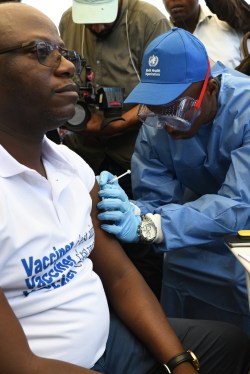
The EPI manager Dr. Guillaume Ngoie Mwamba is vaccinated in the DRC in response to the 2018 Ebola outbreak. Photo: Pascal Emmanuel Barollier/Gavi
What is different about this outbreak from the 2014 crisis? What will be the impact of this particular vaccine?
It’s the same strain, the Ebola Zaire, just like in West Africa. The difference in West Africa is that they hadn’t seen Ebola before; they initially thought it was lassa fever or cholera, so it took a long time for them to realize this was Ebola. As Isaid, the DRC has had nine outbreaks, so the government and health workers are familiar with the situation and were able to say, “Okay, we know this is Ebola, let’s call for help and bring people in.” For the vaccine campaign, they brought in a lot of the vaccinators that worked in Guinea and other countries to help do the vaccination work, because it’s an experimental vaccine under clinical trial protocols, so informed consent is required.
The impact of the vaccine is that once the line-listings are there — it was highly effective in Guinea — if this is an accelerating epidemic and you get good listing of cases, you can stop the epidemic with intervention. The other thing is that you don’t want health workers or others to say “Oh, I got the vaccine now, I don’t have to worry about it!” They still need to use full precautions, because although the vaccine was 100% effective in previous trials, the confidence interval given the size was between 78% and 100%.
In your TED Talk, you mentioned the inevitability of deadly viruses; that they will incubate, that they are an evolutionary reality. On a global level, what more can be done to anticipate epidemics, and how can we be more proactive?
I talked about the concept of prevention: How do you build vaccines for these diseases before they become real problems, and try to treat them like they’re at global health emergency before they become one? There was the creation of the new initiative at last year’s Davos called CEPI (Coalition for Epidemic Preparedness and Innovation) that is working to develop new vaccines against agents that haven’t yet caused major epidemics but have caused small outbreaks, with an understanding that they could. The idea would be to make a risk assessment and leave the vaccines frozen like they were with Ebola; you can’t do a human trial until you have an outbreak.
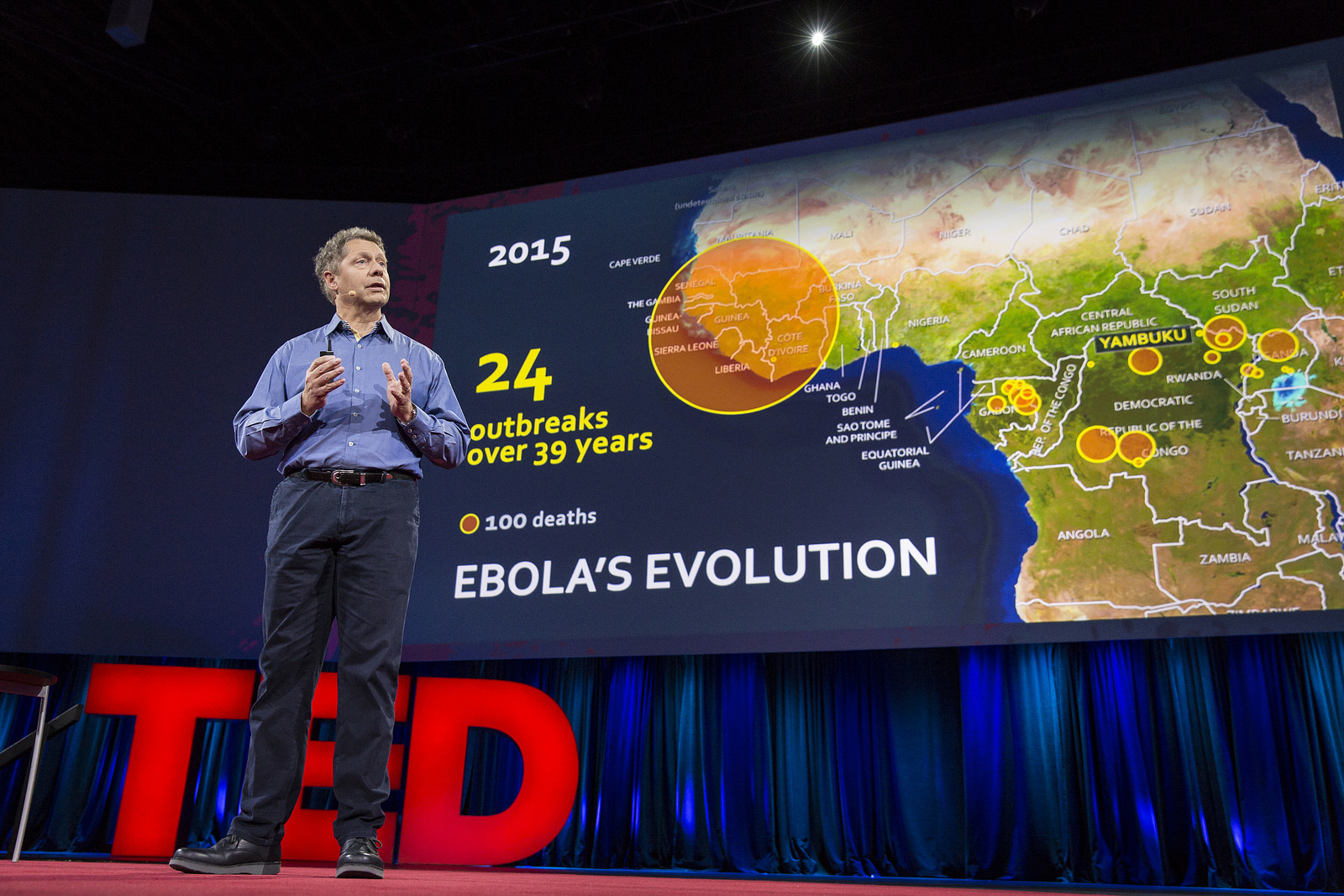
In 2015, at the TED Conference, Seth Berkley showed this outbreak map. During our conversation last week, he told us: “The last outbreak in 2014 was the first major outbreak. There had been 24 previous outbreaks, a handful of cases to a few hundred cases, but that was the first case that had gone in the tens of thousands. This vaccine was tried in the waning days of that outbreak, so we know what it looks like in an emergency situation.” Photo: Bret Hartman/TED
Now, the biggest threat of all — and I did a different TED talk on this — is global flu. We’re not prepared in case of a flu pandemic. A hundred years ago, the Spanish flu killed between 50 and 100 million people, and today in an interconnected world, it could be many, many times more than that. A billion people travel outside of their countries these days, and there are 66 million displaced people. I often have dinner in Nairobi, breakfast in London, and lunch in New York, and that’s within the incubation period of any of these infections. It’s a very different world now, and we really have to take that seriously. Flu is the worst one; the good thing about Ebola is that it’s not so easy to transmit, whereas the flu is really easy to transmit, as are many other infectious diseases.
It’s interesting to go back to the panic that existed with Ebola — there were only a few cases in the US but this was the “ISIS of diseases,” “the news story of the decade”. The challenge is, people get so worked up and there’s such fear, and then as soon as the epidemic goes away, they forget about it. I tried to raise money after that TED Talk, and people in general weren’t interested: “Oh, that’s yesterday’s disease.” We persevered and made sure that in our agreement with Merck that they would produce those doses, even though these are not licensed doses — as soon as they get licensed, they’ll have to get rid of those doses and make more. This was a big commitment, but we said, “Can you imagine what would happen if they had an 100% efficacious vaccine and then an outbreak occurred and we didn’t have any doses of the vaccine?” It was a risky thing to do, but it was the right thing to do from a global risk perspective, and here we are in an outbreak. Maybe it’ll stay small, but right now in the DRC, we’re seeing new cases occurring every day. It’s a scary thing.
The idea that we can make a difference is exciting — we announced the Advance Purchase Commitment in January 2017, and it’s now about a year later and here we have it being used. And it’s amazing that Merck has put this much effort in. They’ve done great work and they deserve credit for this, because it’s not like they’re going to make any money out of this. If they break even, it’ll be lucky. They’re doing this because it’s important and because they can help. We need to bring together all of the groups who can help in these circumstances — it’s the dedication of all the people on the ground from the DRC, as well as international volunteers and agencies, that will provide the systems to get this epidemic under control. There’s a lot of heroes here.
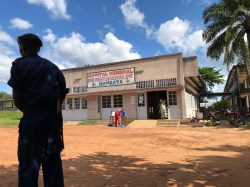
The Wangata Hospital in Mbandaka. Photo: Pascal Emmanuel Barollier/Gavi
The financial aspect is interesting — with the scale and scope of a potential global health crisis like Ebola or the flu, once it’s too late, you wouldn’t even be thinking about the relatively small financial risk of creating a vaccine that could have kept us prepared. Even if there is an immediate financial risk, in the long term, it seems incomparable.
The costs of the last Ebola outbreak were huge. In those three countries, their GDP went from positive to negative, health workers died, it affected health work going forward, travel on the continent, selling of commodities, etc. Even in the US, the cost of vanishing the few cases that were there was huge. Even if you’re a cynic and say, “I don’t care about the people, I’m only interested in a capitalistic view of the world”, these outbreaks are really expensive. The problem is there isn’t necessarily a direct link between that and getting products developed and having them stockpiled and ready to go.
The challenge is investing years ahead of time not knowing when a virus will occur or what the strain is going to be. That’s the same thing here with Ebola — we agreed to invest up to $390 million to create a stockpile, at a time when we didn’t have the money and when others weren’t interested. But if we didn’t have those doses, we’d be sitting here saying, “Well gee, shouldn’t we make some doses now?” — it takes a long time to produce the doses, to quality assure and check them, to fill and finish them, and to get them to the site. [It’s important to have] that be done by the world even when the financial incentives aren’t there.
In an interview with NPR’s TED Radio Hour, you mention the “paradox of prevention”, the idea that we seem to view health care with a treatment-centered approach, rather than prevention. With diseases that kill quickly and spread rapidly, we can’t have a solely treatment mindset, we have to be thinking about preventing it from becoming epidemics.
That is right, but we can’t ignore the treatment too [and the context in which you give it]. Personalize it: If your mother gets sick, and you’re dedicated — you would give your life for your mother in that culture, family takes care of family — do you now ship your mother to a center that you’ve heard through the grapevine will lock her up and isolate her, where she will die alone, or do you hide her and pretend she has malaria or something else? But if a doctor can say, “There might be treatment that can save your mother’s life,” well, then you want to do that for her. It [helps create] the right mindset in the population, to know that people are trying to give the best treatment, that this isn’t hopeless.
How do you think that the current Ebola situation will affect the way that we approach vaccine development? The Advance Purchase Commitment was an instance of an industry innovation. How can we continue to create incentives for pharmaceutical companies to invest in long-term development of vaccines that don’t have an immediate or guaranteed market demand?
Every time we support industry with this type of public-private partnership, it increases confidence that vaccines will be bought and supported, and increases the likelihood of industry engagement for future projects. However, it is important to state that this will not be a highly profitable vaccine. There are opportunity costs associated with it, and risks. The commitment helps but doesn’t fully solve the problem. Using push mechanisms like the funding from BARDA, Wellcome Trust and others, or a mechanism like CEPI, also helps with the risk. In an ideal world, there would be more generous mechanisms to actively incentivize industry engagement. Also, by [offering] priority review vouchers, fast track designations and others, governments can put in really good incentives for these types of programs.
Outside of closely monitoring the DRC, what are the next steps in your work?
We just opened a window for typhoid vaccines. And this is perfect timing as we have just seen the first cluster of extreme antibiotic-resistant typhoid in Pakistan, with a case exported to the UK. Pakistan has already submitted an application for support, and the Gates Foundation has provided some doses in the interim. This is an example where prevention is way, way better than cure.